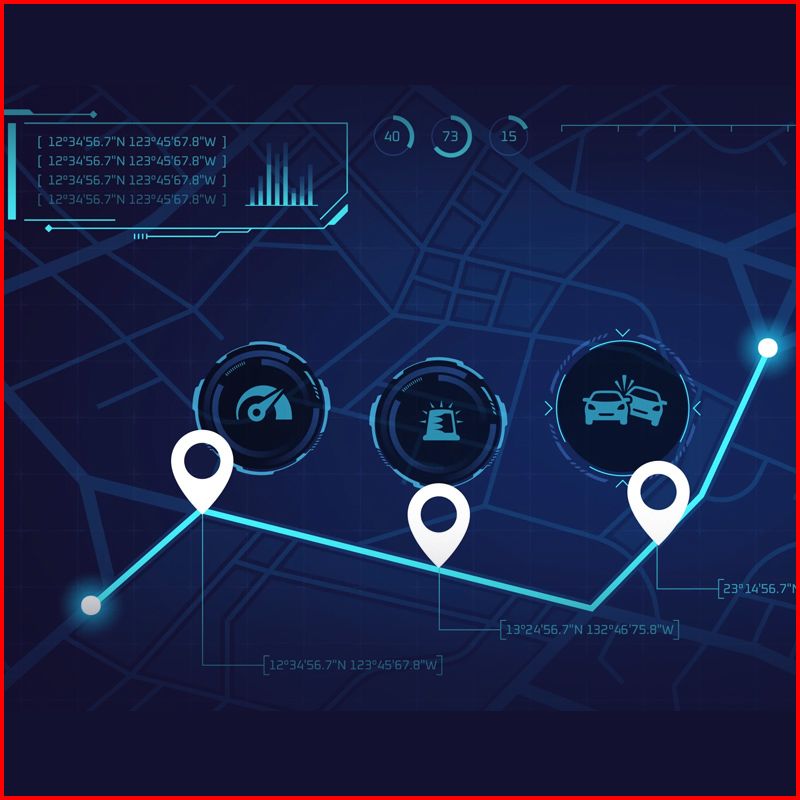The Road to Zero Traffic Fatalities

Eradicating dangers and deaths on highways may seem like an impossible challenge, but the right data and analytics can help law enforcement agencies and states work together to achieve it
When Police Chief Janet Moon of Peachtree City, Georgia, first worked in traffic safety many years ago, paper crash reports with hand-drawn sketches were often unreadable or incomplete. Analyzing such reports to spot trends and help prevent accidents was just as rudimentary – some colored pins on a map based on inaccurate data at least six months old, she recalls.
These days, Moon gets detailed, data-packed crash reports delivered to her desktop almost in real time. At the tap of a finger, she gets instant analysis not only in her own jurisdiction but throughout the state, providing her with the insight and context she needs for informed action.
“We’re constantly checking the data to see where we have traffic issues and where we need to set up controls or consider corrective measures,” says Moon, whose precinct is about 30 miles south of Atlanta. “We’ve become so much more efficient in making roads safer, I couldn’t do my job if I went back to the pins and the papers.
Today, the usage of unstructured data that has been automated and normalized, or data sophistication, enables access to actionable data and analytics in near real time to help law enforcement agencies and state traffic safety professionals across the U.S. to evolve their traffic safety strategies from a reactive mode to a more proactive and even preventive approach in order to reach goals set out in the Road to Zero initiative, a campaign spearheaded by the National Safety Council to reverse the recent spike in highway fatalities.
It calls for doubling down on proven, evidence-based strategies, advancing life-saving technologies in infrastructure and vehicles, and creating a positive safety culture to eliminate roadway deaths by 2050. The analytics enable agencies to be smarter, faster, and more efficient in tackling safety challenges, be it through high-profile and more effective patrolling, improved road infrastructure at key intersections and areas, or community awareness programs.
“Having that data come into the system in an accurate, complete and timely fashion is imperative for traffic safety professionals in the states to carry out analysis and make necessary improvements,” says Jason LaRue, associate vice president of LexisNexis Coplogic Solutions. “The better the data, the more proactive a county or city can be in making traffic safe and preventing accidents.”



Harnessing data to improve safety
The spike in traffic deaths during and after the pandemic – many of which involved poor driver behavior, linked by some psychologists to pandemic stress and increased impulsiveness – has drawn greater focus onto road safety.
But many law enforcement agencies in the U.S. are still stuck in time.
They use paper and pencil instead of a laptop or mobile device, and primitive sketches and wall maps instead of digital visualizations and GPS. Others may use an electronic process but have only limited or siloed data, meaning they can’t share it due to incompatible systems or incomparable methodologies. That makes it impossible to generate dynamic crash analytics in real time. For example, until recently, a county neighboring Peachtree City was unable to join patrol and awareness campaigns because its paper-based data collection left it unable to map current traffic hot spots efficiently.
However, some states are embracing a range of new traffic safety tools. In Georgia an estimated 95 percent to 99 percent of crash reports are now filed via the Georgia Electronic Accident Reporting System (GEARS), produced by LexisNexis Coplogic Solutions for the state.
GEARS, and the other 15 statewide Coplogic Solutions that are in operation across the country, save time and money, and are a big boost to safety management. Crash reports can be filed from the scene of the accident and are typically available in less than 24 hours, compared with a week for paper reports that need to be entered into the system.
The digital reports are available to law enforcement officials and, for a small fee, to authorized parties. That means huge savings for drivers who before had to return to the jurisdiction of an accident to get a physical copy of the report for their insurance claim. That service can also be a source of additional revenue for the county selling the reports online.
Take the example of the I-85 between Atlanta and South Carolina, where there had been repeated cases of head-on collisions resulting in serious injuries and even fatalities. With the help of the reporting system, the Georgia Department of Transportation (GDOT) filtered the accidents for a number of possible causes, from weather conditions to the time of day and age of the driver, and then recommended a remedy.
The installation of cable barriers at four separate locations helped prevent median crossover crashes and dramatically reduced the number of serious injuries and deaths. The high level of location accuracy provided by the electronic data was crucial in getting the devices installed at just the right place.
“We had a net benefit greater than what we had initially estimated. The cost-benefit analysis was very positive, very encouraging,” says Dave Adams, safety manager at GDOT.
Adams is a Sherlock Holmes of traffic accidents. He says there’s a reason for every single one, and likens the job of gathering and analyzing crash data to the work of a forensic team at a crime scene.
Adams gets about 20 calls a month from law enforcement officials struggling to solve a traffic issue. After an initial consultation, he’ll check the database for any pattern among the crashes, carry out a field visit, and then discuss the results with consultants and engineers before making a recommendation.
And that recommendation is worth gold.
Because it’s what determines whether a county spends $10 million on a new overpass to circumvent a dangerous intersection or $10,000 on a couple of warning signs and rumble strips that may mitigate the crashes.
“GEARS informs the engineers what types of crashes happen at a given site – it’s the science, the data that drives our recommendations,” says Adams. “Without it we’d be herding cats.”
Intelligence-based decisions, tailored for each environment
A recent analysis of infrastructure safety improvements designed with the system’s help in Georgia found that the benefits far outweighed the costs of investment. The installation of rumble strips for a specific project costing $1.1 million, for example, ended up reducing the cost of crashes by $40 million over two years, or $200 million over the projected life of the endeavor.
Of course, poor roads or traffic signs are only sometimes a factor in accidents. Road safety practices need to be adapted to weather, as some regions are more affected by ice and snow, while some see higher traffic accidents due to animals crossing roads, particularly when there are wildfires. Then there is simply human behavior, whether it be speeding, texting at the wheel, or driving under the influence of drugs or alcohol (DUI).
For all these causes, data is key to help identify hotspots and respond accordingly. Analytics tell commanding officers where to deploy traffic safety measures, so they’ll make a difference. During the pandemic, for example, Chief Moon was able to see that there was an unusual spike in daytime DUIs and responded accordingly with increased patrols. Speeding, intoxication, fatigue, and distraction – the four main causes of deadly traffic accidents – also surged in 2020 and 2021.
Greater speed of reaction and more open policing
Better and more data allows law enforcement agencies to respond more quickly, too, says Bob Dallas, who as former director at the Governor’s Office of Highway Safety (GOHS) was instrumental in getting the LexisNexis Coplogic Solutions system off the ground in Georgia.
“I think we’re much quicker to develop countermeasures on the behavioral side,” says Dallas. “This is where up-to-date crash data matters – we were able to detect that trend [during the pandemic] pretty early on.” While many states still saw double-digit growth in deadly car accidents in 2022, Georgia was among those that saw a decline for the year.
Using data-driven intelligence to deploy resources is not only a more efficient use of resources, but also introduces a certain transparency and methodology to policing.
“If police officers use data to explain why they are controlling [traffic] at a certain time and place, they’re not only aware and motivated, but can get the community behind them as well, because the public will know this is an evidence-based, not arbitrary control,” says Chief Moon. “It allows us to make ethical, not arbitrary decisions.”
Dallas says the more informed the general public is about awareness campaigns or targeted police controls, the more they will understand them and the more effective they will be. “You want to tell the public what you’re doing, no surprises, no hiding behind the billboard,” he says. “You’re there out front to get positive behavioral change on the roadway. Without that data you don’t have a justification to do anything.”


A ‘north star’ for policymakers
The power of data helps convince not only communities and motorists, but also policy-makers at the local, state, or federal level. Whether it be an awareness campaign on speeding or a budget proposal on traffic safety measures, law enforcement officials in Georgia don’t go to a town or city council meeting without a printout of the latest stats in the bag, says Butch Ayers, executive director of the Georgia Association of Chiefs of Police.
Just how powerful state-wide data on traffic accidents can be was evident when Ayers lobbied legislators in the state assembly who were trying to effectively eliminate school-zone speed cameras. The statistics on accidents in and around school zones going back 10 years that Ayers pulled off the system were so convincing that key legislators reconsidered the idea of doing away with the cameras and instead agreed to work toward a compromise that would reduce their operating hours.
“Without facts, all you have is an opinion, and we had the facts,” says Ayers. “If I didn’t have access to that information, I wouldn’t have been able to talk to those legislators.”
The same holds true when local authorities apply for a grant to improve road safety. The more data there is to back up the request, the better the chances that it succeeds.
Atlanta was one of only two cities nationwide that received a federal grant worth $30 million as part of the Safe Streets and Roads for All (SS4A) program, which has $5 billion in appropriated funds over five years. The proposal to convert two major thoroughfares into safe streets with protected bike and pedestrian facilities was based largely on data generated with the help of the electronic reporting system.
It was the same technology that helped to shed some light on high pedestrian fatality rates on Tara Boulevard in Clayton County and then to support a grant proposal that aimed to fix the problem, says Roger Hayes, director of law enforcement services for the Georgia Governor’s Office of Highway Safety.
The whole process of choosing data-backed projects in some ways helps democratize the way in which tax dollars are spent by ensuring that congressional funds go to who needs it most and not who shouts the loudest, says Hayes. “It allows us to target the jurisdictions that have the most need or the biggest problem.”
As urban centers keep growing, roads get more congested, and traffic becomes more complex with autonomous driving and potentially other forms of transport, traffic safety officials will need all the help they can get to travel the Road to Zero.
“If your goal is to eliminate crashes and serious injuries on roadways, you have to have data that allows you to develop policies,” says Dallas. “If you don’t have data that is accurate, in an electronic form and current, then your policies, your selections, your measurement of success will be flawed. It’s the north star that allows you to get where you need to go to make our roads safer.”
For more information, visit LexisNexis Coplogic Solutions.
